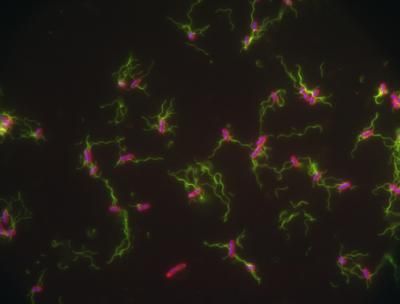Researchers from the University of Basel and Syngenta decode the genome of a plant fungus
Basel, Switzerland. The Biozentrum (Biocentre) of the University of Basel and Syngenta AG will announce today that they have successfully sequenced the genome of the plant pathogenic Ashbya gossypii fungus. This is the first time that the genome of such a fungus has been analyzed. The complete genetic map is of both great scientific value and far reaching practical significance and has already yielded surprising results in basic research, also in the area of genome evolution. Agricultural research will also benefit, e.g. through the functional analysis of important proteins.
Since its establishment in 1981, the Applied Microbiology Research Unit at the Biozentrum of the University of Basel has been carrying out research into Ashbya gossypii. Since 1997, the university has been working on the systematic analysis of its genome in collaboration with Syngenta. This fungus is of major interest because it possesses the smallest known genome of a eukaryote (organisms with nuclei), which consists of nine million base pairs distributed on 7 chromosomes. The composition of the 4720 proteins encoded in the genome is now known.
The Ashbya genome does not have any direct commercial benefit. However, science will use the insight gained from this genome to more quickly and securely recognize the gene function and effect from plant and human pathogenic fungi. Scientists at the Biozentrum and the Swiss Institute of Bioinformatics support the establishment of an Ashbya genome database that will be available to all interested parties. The collaboration between industry and academia has proved its worth in this project.
“We are very proud that we have been able to carry out pioneering work in this area and that our innovative approach has been successful,” says Prof. Peter Philippsen, Team Leader of the Applied Microbiology Research Unit. “Without the major professional collaboration and the financial support of Syngenta, we would not have been able to succeed with such a small team in this challenging scientific task.”
For Syngenta this scientific breakthrough could bring an improved approach in the search for new fungicides. “This is truly an excellent achievement which has produced a great body of useful research,” says Dr. David Evans, Head of Research & Technology at Syngenta. “This will now provide an efficient and innovative platform in the search for new methods of crop protection.”
Topics
Organizations
Other news from the department science

Get the life science industry in your inbox
From now on, don't miss a thing: Our newsletter for biotechnology, pharma and life sciences brings you up to date every Tuesday and Thursday. The latest industry news, product highlights and innovations - compact and easy to understand in your inbox. Researched by us so you don't have to.




















































